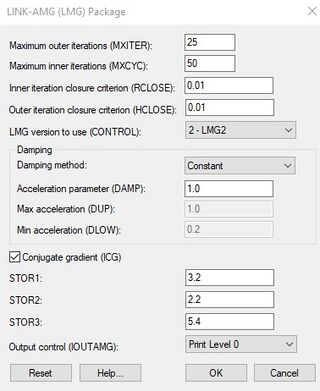GMS:LMG Package: Difference between revisions
From XMS Wiki
Jump to navigationJump to search
No edit summary |
|||
| Line 5: | Line 5: | ||
The [[GMS:LMG1_Package|LMG1 package]] is only supported in GMS versions prior to 8.0. | The [[GMS:LMG1_Package|LMG1 package]] is only supported in GMS versions prior to 8.0. | ||
; MXITER. Maximum outer iterations : This value is the maximum iterations, or calls to the solver. For linear problems, this value can be 2. For non linear problems, this values should be larger, but generally less than 50. | |||
This value is the maximum iterations, or calls to the solver. For linear problems, this value can be 2. For non linear problems, this values should be larger, but generally less than 50. | |||
; MXCYC. Maximum inner iterations : This value is the maximum number of iterations per call to the solver. The default value is 50, and this is sufficient for most problems. | |||
This value is the maximum number of iterations per call to the solver. The default value is 50, and this is sufficient for most problems. | |||
; RCLOSE. Inner iteration closure criterion : Same as RCLOSE for the GMG solver package. The PCG algorithm computes the l2norm of the residual and compares it against RCLOSE. | |||
Same as RCLOSE for the GMG solver package. The PCG algorithm computes the l2norm of the residual and compares it against RCLOSE. | |||
In LMG1 this was called budget closure criterion. When the scaled norm of the matrix equations is less than this value then the solver iteration stops. | In LMG1 this was called budget closure criterion. When the scaled norm of the matrix equations is less than this value then the solver iteration stops. | ||
; HCLOSE. Outer iteration closure criterion : Head change convergence criterion for nonlinear problems. After each linear solve (inner iteration), the maximum norm of the head change is compared against HCLOSE. | |||
Head change convergence criterion for nonlinear problems. After each linear solve (inner iteration), the maximum norm of the head change is compared against HCLOSE. | |||
; CONTROL. LMG version to use : This variable allows the user to select either LMG1 or LMG2 version of the LMG solver. | |||
This variable allows the user to select either LMG1 or LMG2 version of the LMG solver. | |||
; Damping method : Three different damping methods are available: constant, Adaptive damping using the Cooley method, or Adaptive RRR damping using the relative reduced residual. Refer to the official package documentation for more explanation on the different damping methods. | |||
Three different damping methods are available: constant, Adaptive damping using the Cooley method, or Adaptive RRR damping using the relative reduced residual. Refer to the official package documentation for more explanation on the different damping methods. | |||
; DAMP. Acceleration Parameter : This value is used if the acceleration method is set to constant. Usually, this value is 1.0, but for some problems lower values may help achieve convergence. | |||
This value is used if the acceleration method is set to constant. Usually, this value is 1.0, but for some problems lower values may help achieve convergence. | |||
; DUP. Max Acceleration : This is the maximum damping value when using the adaptive damping with relative reduced residual. | |||
This is the maximum damping value when using the adaptive damping with relative reduced residual. | |||
; DLOW. Min Acceleration : This is the minimum damping value when using the adaptive damping with relative reduced residual. | |||
This is the minimum damping value when using the adaptive damping with relative reduced residual. | |||
; Conjugate Gradient : Controls whether the conjugate gradient method is used to accelerate the solver. By default this option is on. | |||
Controls whether the conjugate gradient method is used to accelerate the solver. By default this option is on. | |||
; Stor1, Stor2, Stor3 : These values are ignored in LMG2. In LMG1, these variables are used to control the amount of memory storage used by the solver. The defaults rarely need to be changed. | |||
These values are ignored in LMG2. In LMG1, these variables are used to control the amount of memory storage used by the solver. The defaults rarely need to be changed. | |||
; IOUTAMG. Output control : This controls the information printed to the SAMG output file while the solver is running. | |||
This controls the information printed to the SAMG output file while the solver is running. | |||
; Reset : This button will change all options to the default state. | |||
This button will change all options to the default state. | |||
==External Links== | ==External Links== | ||
